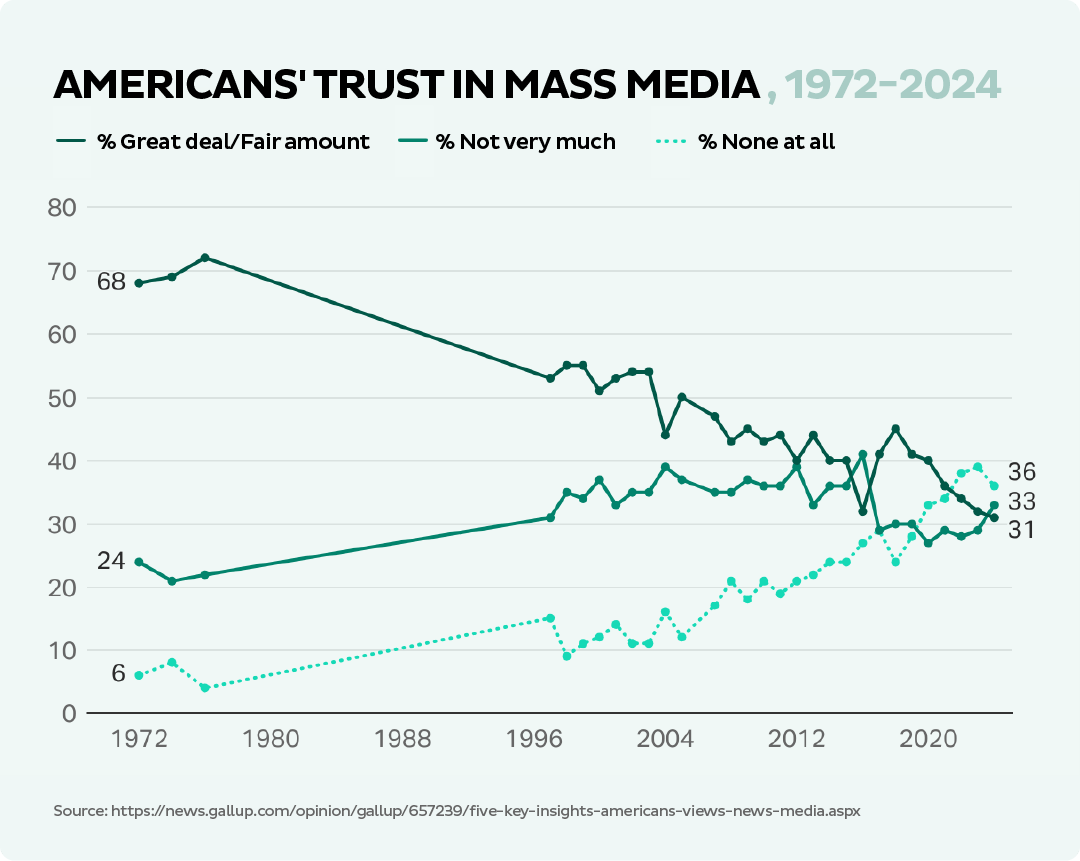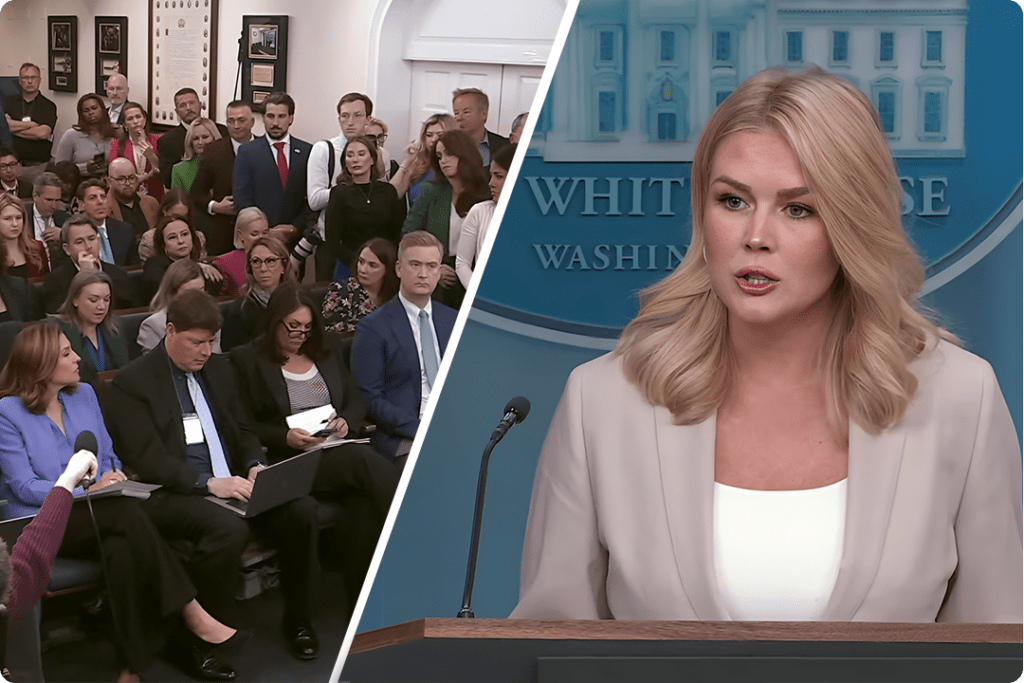Breaking Through the Noise: Public Affairs and Media Strategies in the Trump-Era

Traditional news media have steadily lost influence as a driver of public opinion, and trust in these sources has significantly eroded.
As more audiences shift toward alternative methods for information and news, like social media, influencers, and podcasts, traditional media outlets have lost their once dominant position. And the 2024 Trump campaign may have put the final nail in the coffin of the legacy media.
Losing Faith in Traditional Media
According to Gallup, Americans’ trust in traditional news channels is at a record low, with 36 percent saying they have no trust in media to report the news “fully, accurately, and fairly. “
While Americans lose faith in traditional media, consumption of alternative media sources is rising. 54 percent of Americans say they sometimes get their news from social media, and about one in five Americans regularly rely on news “influencers,” according to Pew Research.

Americans see new media as more approachable and accessible—they’re seeking individualized content that they can relate to. Surprisingly, these new media sources are not just for younger Americans. Both Gen Z and older and rural adults cite cultural alignment and authenticity as reasons for trusting them.
President Trump successfully bypassed the legacy media, speaking directly to targeted audiences on new media platforms with tailored messages and proving that he could control his narrative. This highlighted how legacy media outlets are no longer the gatekeepers of information and cannot rely on their dominance to control discourse.
Adapting to a “Bottom-Up" Approach
Unlike past administrations, President Trump often takes cues from advocates, voters, and new media influencers, making it critical to understand the bottom-up channels shaping his views.
White House Press Secretary Karoline Leavitt has even reserved seats for new media in the tightly packed briefing room, showing the influence new media is bringing to the Oval Office.

Traditional advocacy and earned media tactics must evolve to reflect this reality. As President Trump moves quickly to put his stamp on key national policies, organizations can either win, lose, or face reputational risk based on one Truth Social post or comment during a public appearance.
Monitoring the new media ecosystem shaping President Trump’s perspective is imperative to staying ahead and ensuring messaging reaches the platforms that matter. If you’re not tuned into new media influencers, your organization could be blindsided by a fast-moving story.
It’s also important to understand that the right-leaning media ecosystem does not follow the same content development process as traditional legacy media.
Traditional media follow a top-down process: Investigations, interviews, and reporting are conducted by larger, well-known outlets and broadcast networks before spreading to social channels and local syndications.

This vastly differs from how new media stories evolve from the bottom up. In this ecosystem, the story starts with individual creators on alternative sources such as YouTube, TikTok, and other online forums. They are the ones to identify issues and activate their vast audiences, eventually filtering the story up to more well-known publishers, podcasters, and finally, broadcast media.
Rather than competing to be the first to report or own a story like traditional media, new media creators work to promote one another, share their content, and expand their reach. Some influencers reach larger audiences than traditional TV news programs. For example, CNN prime-time shows draw approximately 663,000 viewers, while Charlie Kirk has 6 million followers on TikTok alone.
Resonating with New Media Influencers and Their Audiences
As with traditional media, outreach to influencers should consider their perspectives, preferred formats, and core issues. Knowing what issues they care about most and the type of format they utilize for sharing news will help organizations engage more effectively.
Influencers value authenticity over highly curated talking points. Many of them are one-man shops and don’t have a newsroom or producer, so outreach must be directly to the influencer. They are open, but skeptical. Like all media, they want to build their influence, so bringing them a CEO or breaking news that’s aligned with their mission is helpful.
To maintain effective advocacy for your organization in this new landscape, it’s important to identify the key individual voices driving discussions around the topics you want to be a part of and that have connections with the audiences you care to reach. Don’t assume the audiences your organization communicates with are not following these new media influencers—with such vast audiences, there is overlap.
New media audiences are very loyal and engaged and will likely remain influential in policy decisions beyond the Trump era, making early engagement and relationship building a smart investment.
Crisis Preparedness in a Fast-Paced Media Landscape
In this always-on media ecosystem, news spreads at an unprecedented rate, and ongoing proactive crisis planning is essential. Teams should identify potential risks, craft response strategies in advance, and anticipate scrutiny.
Organizations must consider multiple factors when preparing for a crisis that can impact their reputation and bottom line. These include understanding potential weaknesses, controversial organizational policies or actions, including those the organization has implemented in the past, and identifying any historical inconsistencies with its mission, customers, or employees.
President Trump is known for publicly calling out businesses, often unexpectedly, making it essential for companies to anticipate potential scrutiny. Knowing where critical narratives may arise in new media and how to combat them is crucial for being well-prepared.
Moving Forward: Staying Agile and Mobilizing New Media Tactics
Public affairs teams must stay agile. This means proactively monitoring trends, refining messaging for new audiences, and engaging with new media influencers.
Companies can no longer rely on mainstream outlets alone to communicate effectively."
For organizations working to drive policy decisions in the Trump era, a multi-channel, audience-first approach is essential to keeping pace with shifting media consumption habits and ensuring awareness of their priorities.
Pairing new media outreach with hyper-targeted digital advertising will effectively reach their highly engaged audiences.
With the right tools and understanding of the dynamics, VOX Global can help identify, monitor and engage new media and their followers – implementing a necessary multi-pronged approach to public affairs campaigns in this new landscape.
Companies should prioritize building strong relationships with credible voices who can amplify their message while maintaining preparedness for potential political scrutiny. By staying informed, adaptable, and strategic, organizations can protect their reputation and maintain a strong, influential presence in public discourse.






